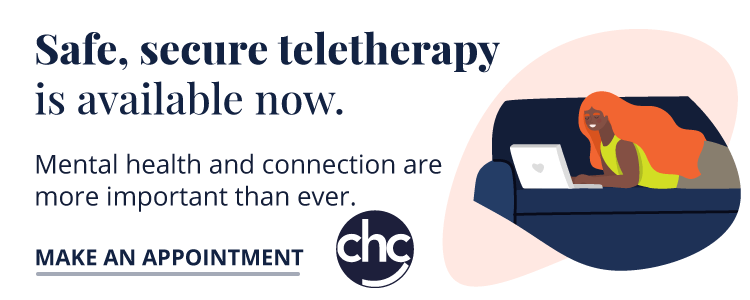February 17, 2021
Cindy Lopez:
[00:00:00] Welcome to Voices of Compassion, CHC’s podcast series providing courage, connection and compassion, highlighting topics that matter to our community, our parents, families, educators, and other professionals. I’m Cindy Lopez, today we’re talking about a practice called radical acceptance. Let’s face it, parts of life are painful. It’s our response to the pain that creates the suffering. In this podcast episode, Dr. Patrice Crisostomo and Leanne Merritt will share from their experience and expertise about radical acceptance: a practice that includes letting go of the illusion of control and developing a willingness to accept things as they are right now. Make sure to listen in, nothing could be more relevant to our lives today.
[00:00:55] So Patty and Leanne, thanks so much for joining us today. I’m really interested in this topic that we’re talking about today, radical acceptance. So let’s start by talking a little bit about what that is. What is radical acceptance and why do you think it’s an especially valuable tool for us right now?
Leeanne Merritt, LCSW:
[00:01:13] So radical acceptance is one of the core principles of Dialectical Behavioral Therapy, and this is a skill that can help us to tolerate feelings of distress. Often when we’re faced with adversity, we’re affected by intense negative emotions, and our natural reaction can be anger, feeling upset and blaming the situation or others for how we feel. We may also ruminate over a past event and have trouble accepting the fact that it did happen, and because the feelings of distress may be so strong and painful, we may have a desire to avoid them and we may become stuck. Distress tolerance is a conscious choice for us to be able to stop resisting and denying the way things are and to work toward accepting them, and what this does not mean is that we have to like or even agree with the situation. We’re just acknowledging the reality of the situation in order to try to reduce the suffering, so pain and nonacceptance combined, caused by trying to change something that really is out of our control. And once we’re able to radically accept that things are a certain way, we can then begin to think about how to work toward changing our behaviors and emotions, in order to overcome challenging circumstances and improve our situation and ultimately our lives.
Cindy Lopez:
[00:02:46] Thank you, Leeanne. So, I can see how this would be really valuable to everyone right now because there seems like there’s so much out of our control, right. So, this tool of radical acceptance gives us a way to kind of feel like I can do something, I think that’s really important right now.
Dr. Patrice Crisostomo:
[00:03:07] Yeah and if I can add, there sometimes are some questions around why do we call it radical acceptance. It’s radical because it means acceptance all the way and accepting reality just as it is, even if we don’t like what the reality is. And it’s just acknowledging what is and allowing ourselves to let go of the fighting against reality, and so this can mean a true acceptance all the way: your mind, your heart, your body complete and total.
Cindy Lopez:
[00:03:41] In your experience in terms of your work with kids and families, like how are people typically responding or reacting to adverse situations or stressful situations?
Dr. Patrice Crisostomo:
[00:03:52] Yeah, so sometimes people will engage in what we call nonacceptance. And so this can come up for a number of different reasons. So for example, people might engage in some magical thinking, like we might think that if we refuse to accept something that’s painful or challenging, it might not happen, or people may push against accepting reality because they may believe that acceptance is the same thing as saying that the situation is okay, but in reality the rejection of what is actually happening doesn’t actually change the painful situation. And so we oftentimes have to first accept what reality is in order to find peace from the suffering that we might be experiencing because of how difficult a situation is at the time. People may also push back on accepting reality because it’s not necessarily something that’s conscious, but an avoidance of relief. You know, I think as humans, we are very much creatures of habit and so we habituate or become used to a level of stress in life and we might accidentally or inadvertently continue to create some auto stress or engage in behaviors that cause more stress in our life. And then lastly, there’s also the strong belief that we can impart change on circumstances that are actually well outside of our control.
Cindy Lopez:
[00:05:29] Thank you for tuning in! Just a note, before we continue on with today’s episode, we hope you’re following us on social media, so you don’t need to wait a whole week between episodes to get engaging, inspiring and educational content from CHC. Our social handles are linked on our podcast webpage at podcasts.chconline.org.
[00:05:52] So if I were to exercise radical acceptance, what are the steps toward practicing that? What should I be doing?
Dr. Patrice Crisostomo:
[00:06:01] Yeah and if I can add to that, so radical acceptance it’s a tough skill because it requires that insight and awareness through knowledge of mindfulness skills. And it also requires a knowledge of relaxation skills, skills of coping and planning ahead and being able to tolerate the painful emotions that might come up if we did start to accept the challenging situation at hand, like feeling sadness or feeling disappointment, if we truly began to accept the fact that we’re in a difficult time right now.
Cindy Lopez:
[00:06:40] So, sounds like mindfulness and self-awareness is critical to, just like everything else in our lives, right, but critical to being able to practice this tool of radical acceptance. I have to be able to know myself well enough that if I keep going down this path, I’m just going to end up, you know, more stressed. So I need to know myself well enough to be able to make a change.
Dr. Patrice Crisostomo:
[00:07:05] Yeah and I would add that radical acceptance in and of itself doesn’t stop pain, but it addresses it’s intended to address the suffering that comes up when there is a painful situation. And on top of that we push back on accepting that challenging or painful situation, that is what contributes to suffering. And so you know, it doesn’t mean we’re giving up on trying to improve or change the situation, but it’s just really more of a refocusing on what aspects of the hard situation do we actually have control over. And so, I think it’s very much a shift in mindset because it has to be in active choice. And so in order to begin to practice radical acceptance, we can start to take steps to think more critically around what the event is and to make a plan to address it. So it does require for example, taking a couple deep breaths, slowing down, being able to think about the event in our life that we’re having trouble accepting or ruminating over. And trying to be as objective as possible and refrain from judging ourselves in the situation, such as saying, I’m stupid because I can’t do this or, you know, the situation is so terrible because even in making those sorts of statements there are judgments about the situation already embedded.
[00:08:42] And the goal is really not to downplay or trivialize the fact that we’re experiencing pain, but more so to accept a realistic or more of a realistic picture of what the issue is. And so one of the things that we can do is begin to just say out loud in more of a neutral voice, what it is we have to accept and to say it slowly, you know, five or 10 times, and saying it out loud is actually important because it has a different power than saying it silently in your mind. And then the next step would be to allow your thoughts about what you need to accept to come into mind and just watch what your body is doing, how your body begins to respond and then to try to relax your body. So there’s this exercise called willing hands where you can begin to just relax all the muscles in your arms, turn your palms facing upwards, rest them in your lap. And then again, using mindfulness skills, noticing if that shifts anything in your body. And then you can also engage in an exercise called a half smile, which means just relaxing the muscles in your face and turning the corner of your mouth slightly up and just seeing if that slight movement in the physiology of your face, if that moves you slightly more towards acceptance. And then imagine believing what you don’t want to accept, imagine what you would do if you had accepted it. What would that look like if you acted as if you accepted this reality that you’re having trouble currently accepting. And allowing your mind to just be gently open to the consequences of the fact that reality is as it is. And that may also involve just allowing yourself to feel sad or disappointed or heartbroken. And then lastly, thinking of a more proactive plan, like what small steps can you begin to make, to take in order to make your situation better. Knowing that it won’t remove the pain, but it can make it easier to move forward. And then, you know, focusing on the positives and the silver linings so that the truth is less painful or to take steps to stop the problems from growing worse.
Cindy Lopez:
[00:11:25] Thank you, Patty, some of your comments remind me of the podcast episode we just did with Dr. Pardis Khosravi about self-compassion and being kind to yourself. So there’s that element in here too, instead of that negative kind of self-talk that gets you going down this path, to kind of change that and exercise some kindness with yourself. I’m wondering if there’s an example of a situation where someone needs this tool of radical acceptance and how they might use it?
Dr. Patrice Crisostomo:
[00:12:01] In working with clients and students, you know, I’ve worked with folks who are struggling with the fact that the end of the semester maybe coming up and with finals and tests that come along with that, they might fixate on the things that they think are unfair about the situation, for example, that they don’t have a good relationship with their teacher or the fact that they’ve been engaging in distance learning for part of the semester. And so they might start to begin to procrastinate or not study, or other examples, you know, people might be going through the process of a really painful breakup or divorce. And so instead of focusing on moving forward and creating a life without that person that they cared about before, someone might be focusing on, you know, trying to win them back or distracting themselves from their pain. You know given the current circumstances with the pandemic, I think some people are struggling with the fact that we’ve been asked to shelter in place for such a long time. And so part of the difficulty with staying consistent with practicing recommendations around wearing masks and physical distancing it can be related to pushing back against the belief that this pandemic is actually happening right now. And that people are at risk for catching this virus if they don’t engage in these behaviors.
Cindy Lopez:
[00:13:34] Patty and Leanne, thank you so much for joining us today, and if there was one thing that you hope our listeners would take away from this episode, what would that be?
Leeanne Merritt, LCSW:
[00:13:45] Radical acceptance doesn’t mean that our thoughts of overwhelm are going to disappear. Radical acceptance is a conscious choice that we need to make continuously, so over and over again, maybe even several times a day. Acceptance is a continuous journey and we have to just continue to turn down that path toward acceptance.
[00:14:06] I would really encourage parents and caregivers to practice self-care and compassion as frequently as they can, and if they do decide to give a try of practicing the skill of radical acceptance to start small. Because as we’ve talked about radical acceptance can be a very difficult skill to learn, and it does take a lot of practice. There have even been some adults who’ve been practicing for years, and still holding onto strong feelings, but it is effective if you can hang in there and stick with it. As parents are maybe giving a try at practicing the skill, their kids can learn that the skill of radical acceptance, parents can role model this skill for kids.
Cindy Lopez:
[00:14:53] Yeah. Thank you, Leeanne. I liked that a reminder to kind of start small, feel good about what you’re doing and the progress you’re making. Thank you.
Dr. Patrice Crisostomo:
[00:15:02] Yeah and to piggyback off of what Leanne said, I would also just add to that it’s not just something that’s a one-time thought exercise because our brains are wired to return back to a more habitual, perhaps a non-accepting stance and so starting small as Leanne said, but also going back to it, if you are beginning to notice that you’re moving back into those thoughts where you’re again pushing back against reality and you’re noticing that you’re experiencing not just the pain of the situation itself, but the suffering that goes along with pushing back from what’s going on.
Cindy Lopez:
[00:15:49] Thank you so much, Leanne and Patty for being with us today and thank you to all of our listeners. And we hope those who are listening, have the opportunity to practice some of these tools that we’re sharing with you, including this one of radical acceptance, and that we also hope we get connected with you again.
[00:16:08] Find us online at podcasts.chconline.org. Also, please follow us on our socials. Find us on Facebook at chc.paloalto and Twitter and Instagram at CHC_paloalto. You can also visit our YouTube channel at chconlinepaloalto. And we are on LinkedIn. Subscribe to Voices of Compassion on Apple podcasts, Spotify and other podcast apps, and sign up for a virtual village email list so you never miss an update or an episode. I always love to hear from you so send me an email or a voice memo at podcasts@chconline.org or leave us a rating and review. We look forward to you tuning in each week. After all we are in this together. See you next week.



